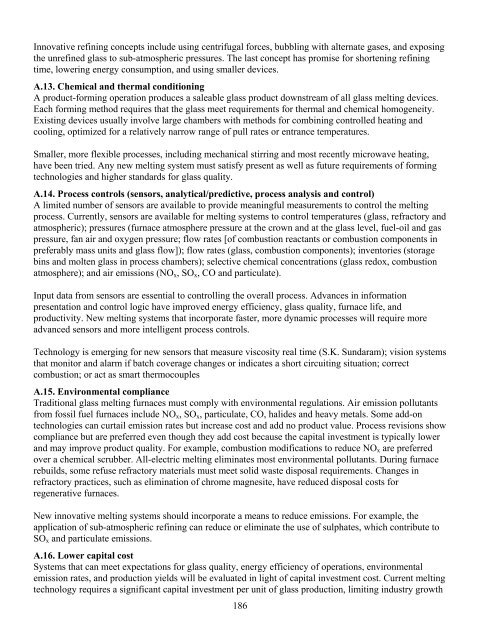Glass Melting Technology: A Technical and Economic ... - OSTI
Glass Melting Technology: A Technical and Economic ... - OSTI
Glass Melting Technology: A Technical and Economic ... - OSTI
Create successful ePaper yourself
Turn your PDF publications into a flip-book with our unique Google optimized e-Paper software.
Innovative refining concepts include using centrifugal forces, bubbling with alternate gases, <strong>and</strong> exposing<br />
the unrefined glass to sub-atmospheric pressures. The last concept has promise for shortening refining<br />
time, lowering energy consumption, <strong>and</strong> using smaller devices.<br />
A.13. Chemical <strong>and</strong> thermal conditioning<br />
A product-forming operation produces a saleable glass product downstream of all glass melting devices.<br />
Each forming method requires that the glass meet requirements for thermal <strong>and</strong> chemical homogeneity.<br />
Existing devices usually involve large chambers with methods for combining controlled heating <strong>and</strong><br />
cooling, optimized for a relatively narrow range of pull rates or entrance temperatures.<br />
Smaller, more flexible processes, including mechanical stirring <strong>and</strong> most recently microwave heating,<br />
have been tried. Any new melting system must satisfy present as well as future requirements of forming<br />
technologies <strong>and</strong> higher st<strong>and</strong>ards for glass quality.<br />
A.14. Process controls (sensors, analytical/predictive, process analysis <strong>and</strong> control)<br />
A limited number of sensors are available to provide meaningful measurements to control the melting<br />
process. Currently, sensors are available for melting systems to control temperatures (glass, refractory <strong>and</strong><br />
atmospheric); pressures (furnace atmosphere pressure at the crown <strong>and</strong> at the glass level, fuel-oil <strong>and</strong> gas<br />
pressure, fan air <strong>and</strong> oxygen pressure; flow rates [of combustion reactants or combustion components in<br />
preferably mass units <strong>and</strong> glass flow]); flow rates (glass, combustion components); inventories (storage<br />
bins <strong>and</strong> molten glass in process chambers); selective chemical concentrations (glass redox, combustion<br />
atmosphere); <strong>and</strong> air emissions (NOx, SOx, CO <strong>and</strong> particulate).<br />
Input data from sensors are essential to controlling the overall process. Advances in information<br />
presentation <strong>and</strong> control logic have improved energy efficiency, glass quality, furnace life, <strong>and</strong><br />
productivity. New melting systems that incorporate faster, more dynamic processes will require more<br />
advanced sensors <strong>and</strong> more intelligent process controls.<br />
<strong>Technology</strong> is emerging for new sensors that measure viscosity real time (S.K. Sundaram); vision systems<br />
that monitor <strong>and</strong> alarm if batch coverage changes or indicates a short circuiting situation; correct<br />
combustion; or act as smart thermocouples<br />
A.15. Environmental compliance<br />
Traditional glass melting furnaces must comply with environmental regulations. Air emission pollutants<br />
from fossil fuel furnaces include NOx, SOx, particulate, CO, halides <strong>and</strong> heavy metals. Some add-on<br />
technologies can curtail emission rates but increase cost <strong>and</strong> add no product value. Process revisions show<br />
compliance but are preferred even though they add cost because the capital investment is typically lower<br />
<strong>and</strong> may improve product quality. For example, combustion modifications to reduce NOx are preferred<br />
over a chemical scrubber. All-electric melting eliminates most environmental pollutants. During furnace<br />
rebuilds, some refuse refractory materials must meet solid waste disposal requirements. Changes in<br />
refractory practices, such as elimination of chrome magnesite, have reduced disposal costs for<br />
regenerative furnaces.<br />
New innovative melting systems should incorporate a means to reduce emissions. For example, the<br />
application of sub-atmospheric refining can reduce or eliminate the use of sulphates, which contribute to<br />
SOx <strong>and</strong> particulate emissions.<br />
A.16. Lower capital cost<br />
Systems that can meet expectations for glass quality, energy efficiency of operations, environmental<br />
emission rates, <strong>and</strong> production yields will be evaluated in light of capital investment cost. Current melting<br />
technology requires a significant capital investment per unit of glass production, limiting industry growth<br />
186

















